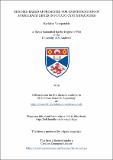Files in this item
Genome-based approaches for identification of avirulence genes in potato cyst nematodes
Item metadata
| dc.contributor.advisor | Jones, John T. | |
| dc.contributor.author | Varypatakis, Kyriakos | |
| dc.coverage.spatial | xxvi, 176 p. | en_US |
| dc.date.accessioned | 2019-08-20T14:55:09Z | |
| dc.date.available | 2019-08-20T14:55:09Z | |
| dc.date.issued | 2019-12-03 | |
| dc.identifier.uri | https://hdl.handle.net/10023/18342 | |
| dc.description.abstract | The use of natural resistance is the most effective way to control the potato cyst nematodes Globodera pallida and G. rostochiensis. Although pathotypes of the latter species can now be fully controlled, control of G. pallida is a real challenge because of the existence of multiple pathotypes with different virulence behaviour. Although the available resistance sources confer partial resistance only, such as that from Solanum vernei (Gpa5) and S. tuberosum ssp. andigena CPC2802 (H3), their use may drive strong selection towards virulence. Resistance operates through the detection of nematode-derived effectors by plant resistance (R) proteins. Upon recognition, immune responses are activated in plants and the recognised effectors are then characterised as avirulence (avr) proteins. The study of the effectors and avr genes can provide important information on the mechanisms underlying selection. Fortunately, the development of novel sequencing technologies and genomic tools have enabled us to gain better insight towards complex genomes, such as that of potato cyst nematodes. Here, long-read sequencing was used for the generation of a new, more complete G. pallida genome. Based on this, analysis of captured, targeted effector-encoding genomic regions from virulent populations selected on the above resistance sources showed the presence of up to 54 candidate effectors that may determine virulence on these resistance sources. By cross-referencing those with the candidates identified from the re-sequencing of the same populations, 3 high-confidence candidate avr genes were listed. In parallel, the analysis of their allele frequencies and SNP distribution revealed that many potential effector genes are located within genomic “islands”, which are all selected on a specific resistance. This organisation is believed to facilitate selection evolution and host adaptation. Lastly, the G. rostochiensis candidate effector g13394 was cloned from an avirulent and virulent to H1 population, and subsequently was functionally validated through Agrobacterium-mediated transient expression using two different methods. | en_US |
| dc.description.sponsorship | "This work was supported by The James Hutton Institute and the Agriculture and Horticulture Development Board (AHDB) Potatoes." -- Acknowledgements | en |
| dc.language.iso | en | en_US |
| dc.publisher | University of St Andrews | |
| dc.rights | Creative Commons Attribution-NonCommercial-NoDerivatives 4.0 International | * |
| dc.rights.uri | http://creativecommons.org/licenses/by-nc-nd/4.0/ | * |
| dc.subject | Potato cyst nematodes | en_US |
| dc.subject | Next-generation sequencing | en_US |
| dc.subject | Avirulence genes | en_US |
| dc.subject | Host adaptation | en_US |
| dc.subject | Resistance | en_US |
| dc.subject.lcc | SB608.P8V2 | |
| dc.subject.lcsh | Potatoes--Disease and pest resistance | en |
| dc.subject.lcsh | Plant diseases | en |
| dc.subject.lcsh | Genomics | en |
| dc.subject.lcsh | Nematodes | en |
| dc.title | Genome-based approaches for identification of avirulence genes in potato cyst nematodes | en_US |
| dc.type | Thesis | en_US |
| dc.contributor.sponsor | Great Britain. Agriculture and Horticulture Development Board | en_US |
| dc.contributor.sponsor | James Hutton Institute | en_US |
| dc.type.qualificationlevel | Doctoral | en_US |
| dc.type.qualificationname | PhD Doctor of Philosophy | en_US |
| dc.publisher.institution | The University of St Andrews | en_US |
| dc.publisher.department | The James Hutton Institute | en_US |
| dc.identifier.doi | https://doi.org/10.17630/10023-18342 |
The following licence files are associated with this item:
This item appears in the following Collection(s)
Except where otherwise noted within the work, this item's licence for re-use is described as Creative Commons Attribution-NonCommercial-NoDerivatives 4.0 International
Items in the St Andrews Research Repository are protected by copyright, with all rights reserved, unless otherwise indicated.


